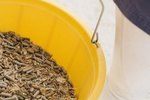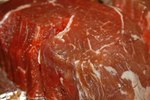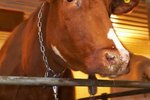Beet pulp is the byproduct of processing sugar beets. The feed is useful to provide nutrition during the winter months when fresh pasture isn't available. Beet pulp comes in pellets or shreds, but feeding rehydrated shreds provides the best way to ensure your sheep doesn't get bloat and choke.
Bloat and Choke
Fermentation is a natural part of a sheep's digestive action but when it occurs too quickly, it results in a potentially fatal condition called bloat. Choke happens when food gets stuck in the esophagus and prevents a sheep from belching out gas caused by fermentation in the rumen. Gases build up inside the animal, evidenced by the left side becoming distended. As the condition progresses, the distended rumen presses on the diaphragm, making it difficult for the sheep to breathe. Without intervention, the sheep eventually dies of respiratory and cardiac failure.
Soaking It Up
Sheep eating pellets of any kind are more prone to bloat than animals eating whole foods. Prevent choke or bloat caused by beet pulp shreds by rehydrating the pulp until it is fully expanded but isn't fermenting. Add 1 part beet pulp to 2 parts water and allow it to soak for 30 minutes if using warm water or an hour with cold water. The beet pulp will be fluffy and more than double in volume. Drain any excess water from the beet pulp before feeding.
How Much
Introduce beet pulp gradually, substituting a little of the diet at a time over the course of several weeks. Normal sheep consumption of beet pulp ranges from 2 to 10 pounds per day. Keep in mind that beet pulp contains only 9 to 10 percent protein, so use it in addition to quality hay, not as a replacement.
Writer Bio
Indulging her passion for vacation vagary through the written word on a full-time basis since 2010, travel funster Jodi Thornton-O'Connell guides readers to the unexpected, quirky, and awe-inspiring.




